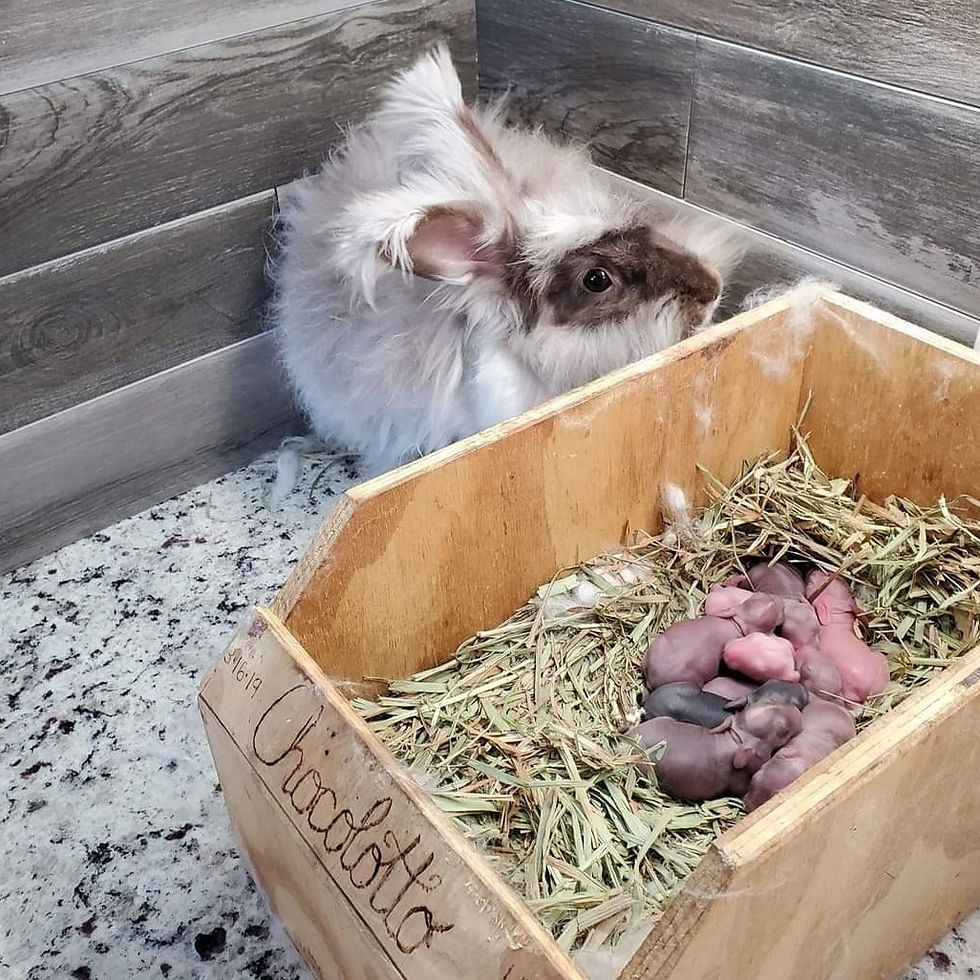What is shelving?
Separating the kits from the momma doe at all times except for feeding.
How often to feed?
We feed twice daily, shooting for 12 hours apart. For us, 9:00AM and 9:00PM works the best. Choose a 12 hour timespan that works best for your schedule.
Why should I shelf my kits?
Shelving prevents death of the kits by the doe or cold snaps/heatwaves. Sometimes the mama bunny will bite or even eat her kits. Other times the kits can get squished. Sometimes kits will still be latched onto a nipple when the doe jumps out of the nest box which results in the kit being left on the cold wire. We shelf kits to avoid all of these unfortunate circumstances.
What other benefits come from shelving?
We have noticed that shelving kits makes for much friendlier rabbits. We've also had zero cases of nest box eye. We have shelved 8 litters through to the full 8 week mark with zero kit deaths. That is over 50 healthy thriving babies!
Commitment & Is Shelving Right For You?
The first 4-5 weeks of the kit's lives you can expect to be working with them for approximately 15-30 minutes, twice daily, for 1-2 litters. Schedule cleaning once a week. The last 5-8 weeks will include once a day feedings, grooming and cage cleaning. It may not sound like much now but after a long day of work it may be the last thing you want to do. Those tiny helpless babies will be relying on you to bring them their food source and provide a safe, clean environment from you around the clock. Vacations and weekend getaways? Maybe you can find a trusted pet sitter or family member but we ended up traveling with our entire shelving set up of 4 does and 30+ babies. The shelving process takes commitment. If you start the litter off by shelving you will have the most success seeing it through to the end.

Other tips
If you have a mama that is prone to biting/eating or crushing the kits, you can hold them by the scruff or ears *gently* to prevent them from biting, or control where they sit to nurse.
We use paper bedding as it is more insulating than hay, more absorbent than hay, and helps to prevent nest box eye from developing. Keep the bedding clean to ensure healthy kits throughout the process. If you notice that the batch of paper bedding you purchased is particularly dusty then make sure you try to shake the dust out a bit before placing kits in it.
If you have any other questions, please feel free to message us through the website and we will get back to you as quickly as possible.
*TIMELINE*
Prior to birth
Place 4-5 inches of paper bedding into small animal carrier
After Birth
Pull kits from nest box and place in the animal carrier.
Attempt the first nursing session at the 12 hour mark of your choosing. If they are born in the morning but they look full and healthy then begin the nursing schedule at the evening time you have set for them. 9:00PM work for us. The second feeding will come at 9:00AM and repeat feedings every 12 hours.
The mama bunny may not get her milk in for a full 24 hours. Don't freak out! This is totally normal. To get her milk to come in faster, do not miss a single feeding. Keeping a very consistent schedule will be your best friend.
Handle the babies as little as possible during their first few days on earth. They generate heat by wiggling around in a cluster with their siblings. Pulling them out several times a day (other than for feedings) will make them burn calories a lot faster as they try to stay warm. This will give them a weak start to life and we want them to be strong!
Week 1
Feed kits twice daily for 5-10 minutes each, roughly 12 hours apart. Lean your ear down to the nest box. You should hear the kits suckling!
Remove kits from the carrier and place in a nest box
Add the dam (mama) to the nest box
After 5-10 minutes the kits should have very full bellies. If you hold a kit on it's back with your left hand you should see a milk spot near your ring finger in the belly. Use this method of making sure the kit ate with smaller babies that aren't getting the obvious beach ball shape.
Put the dam back in her cage and place kits back in the carrier
Week 2
Change out bedding
Continue the same feeding habits, but begin to introduce hay to the animal carrier.
You should notice the kits begin to take interest in the hay.
The kits will being to urinate more heavily, so change bedding as needed. Typically every 3-5 days
Eyes will begin to open!!! If you notice that a kit is a bit behind on opening their eyes and developing a small crust around the eye slit then take a rag with warm water on the corner and hold it to the eye for about 3 minutes. The rag will need to be pretty damp but not dripping. This will soften up the crust and allow the eyes to open.
Ear canals have opened around the beginning of week 2!!! They will now begin to recognize your voice and certain sounds. Our door that we bring the mama bunnies through squeaks and they begin to start correlating that sound with feeding times.
Week 3 -6 - *Varies on litter size and breed*
If you didn't need to change the bedding out last week, change it out at the beginning of week 3
Continue the same feeding habits, but add more hay
Change bedding as needed. Clean bedding means healthy kits!
As the kits begin to grow, you will need to move them to a larger cage. Do this at your discretion. We typically make the transition during week 3 to a bedding lined cage with a solid floor and transition again to a wire bottom cage at week 6.
Fill the cage with a few inches of fresh paper bedding and introduce water and pellets along with unlimited hay.
We use porcelain bowls for water and pellets, but also add a hay feeder, j-feeder and water bottle.
Week 7
The kits should now be eating the pellets and hay, and drinking the water. Be sure to keep everything topped off.
Begin to ween the kits from mom by feeding once daily. (It is not uncommon for some litters to be completely weaned by this stage and thriving.)
It is important to watch the kits weight during this process. If any of the kits are struggling to maintain a healthy weight, change the nursing schedule to 2 feedings every other day, with 1 feeding on the days in between.
Week 8
The kits should be weened! YAY!
If you made it this far, congrats on successfully shelving your first litter!

Supplies needed
Small animal carrier - https://www.chewy.com/living-world-small-animal-carrier-red/dp/129108
The 1.5 cup bowls seem to be the perfect size https://www.chewy.com/ethical-pet-stoneware-crock-pet-dish/dp/56323
Hay feeder - https://www.chewy.com/ware-small-animal-hay-feeder/dp/128620
Water bottle - https://www.chewy.com/lixit-quick-lock-flip-top-rabbit/dp/131590
Bedding - https://www.chewy.com/carefresh-small-animal-bedding-blue/dp/122271
Small cage - https://www.chewy.com/ware-home-sweet-home-plastic-small/dp/128652
Wire Bottom Cage - https://www.kwcages.com/cages/rabbit-stacking-cages/series-4000-36-x-30-x-18.html


















Comments